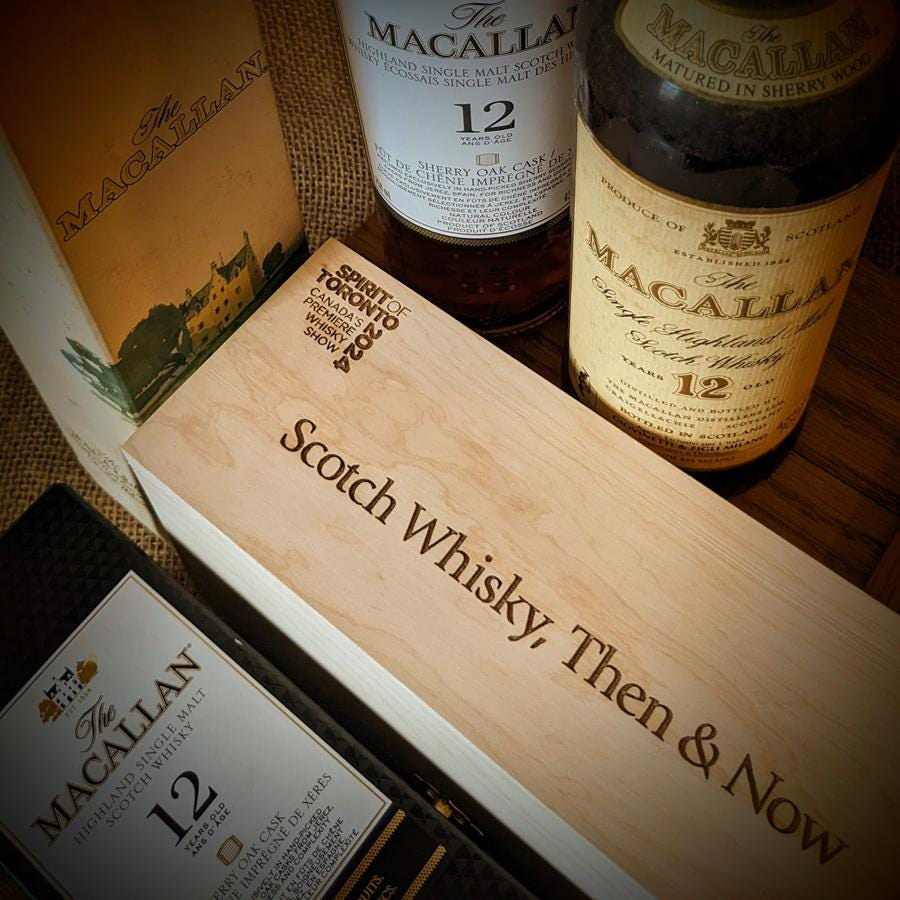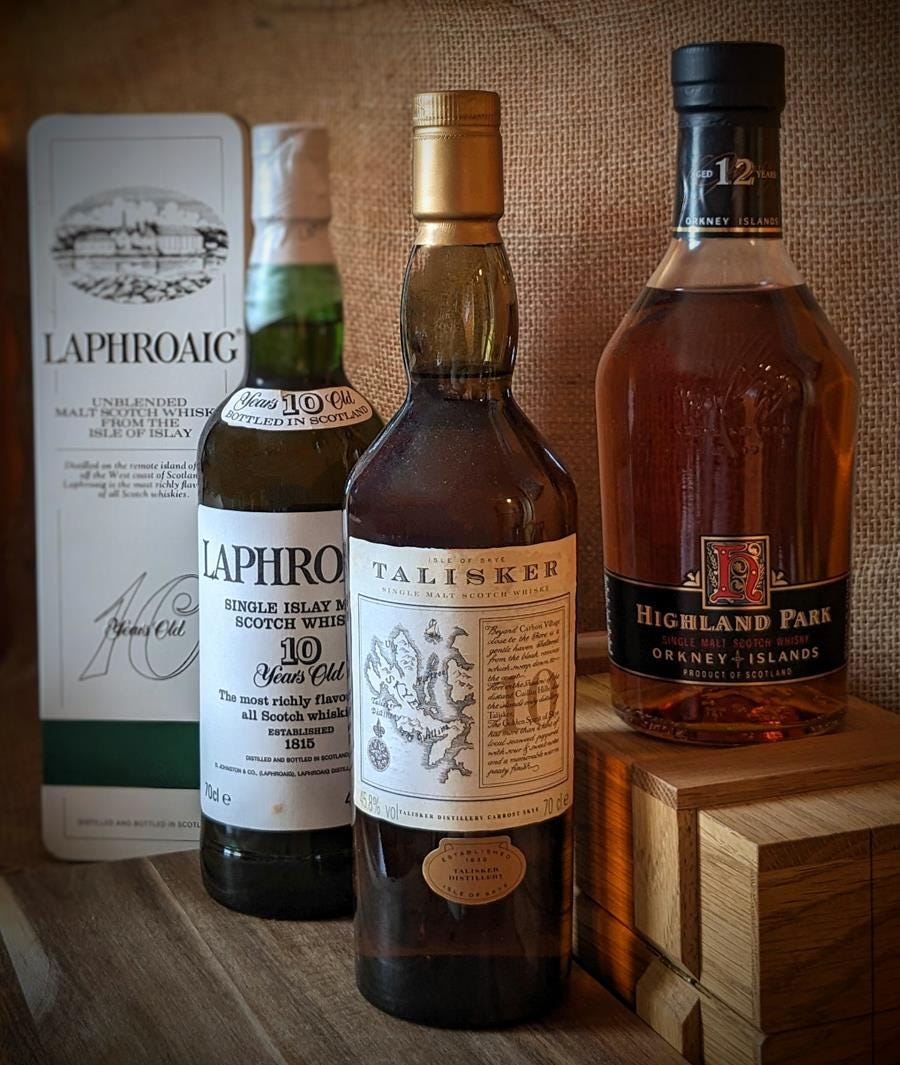Time, a cruel mistress after all?
That she yoked me in January and has dragged me to mid-November without a moment to catch my breath leaves me nodding my head in agreement with this hoary old chestnut.
As does the cognoscenti, those whisky savants who vow, deep in their bones, that whisky of yesteryear was better, as they happily bid at auction and gatekeep their precious elixir from the rank-and-file, the ones who missed whisky’s heyday and are relegated to drinking everyday malts from the middle shelf (and at inflated prices, the ignominy!)
But all that’s dusty is not gold: I say this from firsthand experience, having had some very mid whisky from very dusty bottles. Yes, exceptions prove the rule but I’ve always though it would be far more meaningful to consider the past versus the present in a wider light, one that looks at Scotch whisky as a whole, in a comparison that covers its most highly regarded distilleries.
As long-in-the-tooth whisky stans this kind of fussy, contemplative and expensive deep dive is a wholly appropriate way of celebrating 20 years of Spirit of Toronto. We wouldn’t still be presenting such an event if we didn’t truly appreciate whisky with all the peaks, troughs, oddities, surprises and minutiae it has to offer. What better way to celebrate and indulge our decades-long fascination than to analyze its changes over the past forty years?
As the kids say, too long, didn’t read: this masterclass is all about tasting the bottles we’ve been longing to open, alongside the conversation we’ve been longing to have – was Scotch whisky from yesteryear actually better? Joining us for the craic, knowledge and insight is writer and historian Fionnán O’Connor. Our previous session with Finn ran over three hours; if there’s a more knowledgeable, more passionate or more intense whisky academic out there, then someone please introduce me.
The premise of this tasting is simple: from ‘modern’ casks to fermentation times to yeast strains to barley varieties to ‘old bottle effect’ — was whisky of yesteryear empirically better? Certainly no shortage of aficionados and collectors who would have us believe as much, convinced that the Golden Age of whisky is behind us, while they mourn the good old days when Scotch was truly on its game…
But only a Sith deals in absolutes. While it can’t be denied that there’s gold in some of them thar dusty bottles, we’ve also had our fair share of mid whisky from yesteryear so caveat emptor – not all that’s dusty is gold, and certainly not to the extent that auctioneers and collectors might have us believe.
Of the six blind pairs we’ll be tasting in a few weeks, The Macallan 12 Year Old will be the most anticipated, and rightly so: for many connoisseurs The Macallan of yore is the stuff of legend, and these bottles command prices to match, so much so that we were hesitant to open such a pricey collectible. But as our friend Paul likes to say, “we’ve got to go there”. And snap, out comes the cork as we gird our loins and prepare to pit this beauty – birthed from Golden Promise barley and matured in genuine sherry casks – against its present day doppelganger, as now matured in 21st century ‘seasoned’ casks.
Since the evolution of sherry casks will be a salient point of this masterclass, it will be interesting to taste its effect on Glenfarclas over a span of forty years. The Glenfarclas 15 Year Old is a whisky we’ve long held in high esteem, reputedly the only ’farclas bottled at 46% because it’s the owner’s favourite. This 80s baby in a square bottle is of a much darker hue than what is currently being bottled, and we’ve been champing at the bit to get stuck into this relic, so to speak.
But then again, all that’s sherried is not gold!
While Glendronach’s current stock in trade is a frenzy of sherry, this only came about in the early 90s as Macallan’s popularity gained steam. Previously Glendronach was bottled from mostly bourbon casks, with just enough sherry to bring out the malt’s fruitiness. I personally adore this side of Glendronach, and can’t wait to explore this dumpy green 80s dusty, a throwback to an era when The Glendronach 12 Year Old was one of just a handful of single malt whiskies being sold in Canada.
That said, it’s with the island malts where I’m anticipating the biggest curveballs – Laphroaig, Highland Park, and my beloved Talisker.
The true geeks among you will notice that the Laphroaig 10 Year Old we’ll be tasting does not feature the royal warrant that appeared on the label after (then) Prince Charles visited the distillery when he crashed his plane on Islay in 1994. Peat freaks take note: our own experience is that Laphroaig is more pungent and intense the further back you go, so we’re like kids in a candy store waiting to taste this early 90s dusty next to Laphroaig 10 Year Old of the moment.
Highland Park 12 Year Old is another Grand Cru malt that has undergone radical changes to its packaging, marketing and – for many of us – its character profile. But for better or worse is the question, and we relish the opportunity for an A/B comparison of Highland Park’s flagship 12 Year Old circa 1980s next to its current cosplay as a Viking warlord.
Last but not least is our beloved Talisker 10 Year Old, a malt and a distillery that hold a special place in the hearts of whisky lovers at large. As a single malt whisky Talisker has gone from being an eight-year-old (heaven!) to a twelve-year-old (rapture!) to a 10-year-old bottled as part of the Classic Malts collection marketed by Diageo in the 90s, featuring the ‘map’ label sought after by collectors.
Our two cents? Talisker is no slouch, and little has changed with its house style over the years. It makes this whisky perhaps the best benchmark for comparing ‘Then’ versus ‘Now’. And truthfully, it’s the only one where we’re bracing ourselves for a possible stalemate…










